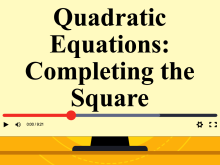
Illustrative Math Alignment: Grade 8 Unit 3
Linear Relationships
Lesson 12: Solutions to Linear Equations
Use the following Media4Math resources with this Illustrative Math lesson.
| Thumbnail Image | Title | Body | Curriculum Topic |
|---|---|---|---|

|
Video Tutorial: Anatomy of an Equation: Two-Step Equations 2 | Video Tutorial: Anatomy of an Equation: Two-Step Equations 2
TopicEquations DescriptionThis segment covers equations involving addition and multiplication where a negative number appears. It emphasizes isolating the variable by subtracting the constant, simplifying, and dividing by the coefficient. Vocabulary includes isolate, simplify, and negative numbers. Applications extend algebraic problem-solving skills with negative values. |
Solving Two-Step Equations |

|
Video Tutorial: Anatomy of an Equation: Two-Step Equations 3 | Video Tutorial: Anatomy of an Equation: Two-Step Equations 3
TopicEquations DescriptionThis video introduces solving equations with subtraction and multiplication. Steps include adding the constant to isolate the variable and dividing by the coefficient. Vocabulary includes subtraction, isolate, and coefficient. Applications enhance understanding of balancing equations with subtraction operations. |
Solving Two-Step Equations |

|
Video Tutorial: Anatomy of an Equation: Two-Step Equations 4 | Video Tutorial: Anatomy of an Equation: Two-Step Equations 4
TopicEquations DescriptionThis segment focuses on handling subtraction and multiplication when a negative number is involved. Techniques include adding the constant, simplifying, and dividing by a positive coefficient. Vocabulary includes subtraction, negative coefficient, and isolate. Applications involve solving equations with more complex negative value interactions. |
Solving Two-Step Equations |

|
Video Tutorial: Anatomy of an Equation: Two-Step Equations 5 | Video Tutorial: Anatomy of an Equation: Two-Step Equations 5
TopicEquations DescriptionThis tutorial demonstrates equations with addition and negative coefficients. The process involves subtracting the constant, simplifying, and dividing by the negative coefficient. Vocabulary includes negative coefficient, simplify, and inverse operation. Applications refine algebraic methods in equations with negative variable multipliers. |
Solving Two-Step Equations |

|
Video Tutorial: Anatomy of an Equation: Two-Step Equations 6 | Video Tutorial: Anatomy of an Equation: Two-Step Equations 6
TopicEquations DescriptionThis video examines equations with addition, multiplication, negative coefficients, and negative constants. It outlines steps to isolate the variable, simplify, and divide by the negative coefficient. Vocabulary includes negative constants, simplify, and isolate. Applications improve skills in handling equations with layered negative components. |
Solving Two-Step Equations |

|
Video Tutorial: Anatomy of an Equation: Two-Step Equations 7 | Video Tutorial: Anatomy of an Equation: Two-Step Equations 7
TopicEquations DescriptionThis segment focuses on equations with subtraction and negative coefficients. Steps include adding the constant, simplifying, and dividing by the negative coefficient. Vocabulary includes negative coefficient, isolate, and subtraction. Applications highlight algebraic problem-solving with negative coefficients. |
Solving Two-Step Equations |

|
Video Tutorial: Anatomy of an Equation: Two-Step Equations 8 | Video Tutorial: Anatomy of an Equation: Two-Step Equations 8
TopicEquations DescriptionThis video presents subtraction, multiplication, and negative coefficients alongside negative numbers. Solving requires adding the constant, simplifying, and dividing by the negative coefficient. Vocabulary includes subtraction, negative values, and isolate. Applications stress solving equations with multiple negative components. |
Solving Two-Step Equations |

|
Video Tutorial: Anatomy of an Equation: Two-Step Equations 9 | Video Tutorial: Anatomy of an Equation: Two-Step Equations 9
TopicEquations DescriptionThis tutorial covers equations involving addition and division. Key steps are subtracting the constant and multiplying by the reciprocal of the divisor. Vocabulary includes reciprocal, division, and isolate. Applications build on foundational algebraic techniques involving division. |
Solving Two-Step Equations |

|
Video Tutorial: Linear Functions, Video 1 | Video Tutorial: Linear Functions, Video 1
TopicLinear Functions DescriptionThe video covers linear functions with positive slope and positive y-intercept. It explains the slope-intercept form y = mx + b, where m is the slope indicating steepness, calculated as rise over run, and b is the y-intercept, the y-value at the point where the line intersects the y-axis. For this function, the slope is 2, and the y-intercept is 2. The graph is demonstrated by moving up two units and one to the right, confirming the slope. The y-intercept at point (0, 2) is also identified. |
Graphs of Linear Functions |

|
Video Tutorial: Linear Functions, Video 2 | Video Tutorial: Linear Functions, Video 2
TopicLinear Functions DescriptionThis video discusses linear functions with positive slope and negative y-intercept. It reviews the slope-intercept form y = mx + b. The slope measures steepness as the ratio of rise to run, and the y-intercept is the point where the line meets the y-axis. Here, the slope is 2, and the y-intercept is -3, evidenced by the graph where the line starts at (0, -3) and rises two units for every unit right. |
Graphs of Linear Functions |

|
Video Tutorial: Linear Functions, Video 3 | Video Tutorial: Linear Functions, Video 3
TopicLinear Functions DescriptionThe video explains linear functions with a positive slope and zero y-intercept. In slope-intercept form y = mx + b, the slope, m, represents the steepness, while the y-intercept, b, is zero. The slope of 2 is confirmed by graphing: moving up two units and one to the right. The line passes through the origin, demonstrating a y-intercept of 0. |
Graphs of Linear Functions |

|
Video Tutorial: Linear Functions, Video 4 | Video Tutorial: Linear Functions, Video 4
TopicLinear Functions DescriptionThis video focuses on linear functions with a negative slope and positive y-intercept. Using the slope-intercept form y = mx + b, the slope of -3 indicates a downward slope, and the y-intercept of 2 is the point (0, 2). Graphically, moving down three units and one unit to the left confirms the slope of -3. |
Graphs of Linear Functions |

|
Video Tutorial: Linear Functions, Video 5 | Video Tutorial: Linear Functions, Video 5
TopicLinear Functions DescriptionThe video covers linear functions with a negative slope and negative y-intercept. It explains the slope-intercept form y = mx + b, with a slope of -3 and a y-intercept of -2 at (0, -2). The graph shows a downward slope with three units down and one unit left, confirming the slope. |
Graphs of Linear Functions |

|
Video Tutorial: Linear Functions, Video 6 | Video Tutorial: Linear Functions, Video 6
TopicLinear Functions DescriptionThis video addresses linear functions with a negative slope and zero y-intercept. In slope-intercept form y = mx + b, the slope is -3, indicating a downward trend. The line passes through the origin, confirming the zero y-intercept, and graphing demonstrates the negative slope. |
Graphs of Linear Functions |

|
Video Tutorial: One-Step Equations: Addition | Video Tutorial: One-Step Equations: Addition
TopicSolving Equations DescriptionThis video introduces one-step equations that require one mathematical operation to solve. The focus is on addition equations, indicated by the addition symbol. The solution process involves using subtraction to isolate the variable. Key math concepts include solving equations, inverse operations, and maintaining equation balance. Key vocabulary includes addition, subtraction, equation, and inverse operation. Practical applications involve basic algebraic problem-solving. |
Solving One-Step Equations |

|
Video Tutorial: One-Step Equations: Division | Video Tutorial: One-Step Equations: Division
TopicSolving Equations DescriptionThis video covers one-step division equations, identifiable by the division symbol or fraction notation. Multiplication is applied as the inverse operation to solve for the variable. Key concepts include solving equations, inverse operations, and keeping equations balanced. Vocabulary emphasized includes division, fraction, multiplication, inverse operation, and equation. These equations are practical for solving proportional problems and foundational algebraic expressions. |
Solving One-Step Equations |

|
Video Tutorial: One-Step Equations: Multiplication | Video Tutorial: One-Step Equations: Multiplication
TopicSolving Equations DescriptionThis tutorial demonstrates solving one-step multiplication equations. Such equations are characterized by a coefficient next to the variable. Division is used to isolate the variable. The key math concepts are solving equations, using inverse operations, and maintaining balance. Important vocabulary terms include multiplication, coefficient, variable, division, and inverse operation. Applications include foundational algebra skills for understanding more complex equations. |
Solving One-Step Equations |

|
Video Tutorial: One-Step Equations: Subtraction | Video Tutorial: One-Step Equations: Subtraction
TopicSolving Equations DescriptionThis video explains how to solve one-step subtraction equations. These equations are identified by the subtraction symbol, and solving them involves using addition to isolate the variable. Key concepts discussed are solving equations, inverse operations, and keeping equations balanced. Important vocabulary includes subtraction, addition, inverse operation, and equation. Applications include solving simple algebra problems encountered in everyday contexts. |
Solving One-Step Equations |

|
Video Tutorial: Slope and Similar Triangles | Video Tutorial: Slope and Similar Triangles In this video explore the relationship between slope and similar triangles. |
Slope |

|
Video Tutorial: Slope Formula, Video 10 | Video Tutorial: Slope Formula, Video 10
TopicSlope DescriptionThe video discusses a negative slope with points in Quadrants I and II. Using (4, 2) and (-2, 8), it calculates a slope of -1. Highlights include rise over run and coordinate simplifications. This video illustrates the Slope, highlighting key mathematical concepts. Students will learn about the derivation and application of the slope formula through concrete examples and clear explanations. This lesson offers a foundational understanding crucial for graphing linear equations and interpreting real-world scenarios. |
Slope |

|
Video Tutorial: Slope Formula, Video 11 | Video Tutorial: Slope Formula, Video 11
TopicSlope DescriptionThis video demonstrates finding a positive slope with points in Quadrants III and IV. Using points (-5, -9) and (3, -5), it calculates a slope of 1/2. Concepts covered include rise over run and simplifying coordinate differences. |
Slope |

|
Video Tutorial: Slope Formula, Video 12 | Video Tutorial: Slope Formula, Video 12
TopicSlope DescriptionExplains calculating a negative slope for points in Quadrants III and IV. Example points (7, -5) and (-5, -1) yield a slope of -1/3. Key topics include applying the slope formula and simplifying results. This video illustrates the Slope, highlighting key mathematical concepts. Students will learn about the derivation and application of the slope formula through concrete examples and clear explanations. This lesson offers a foundational understanding crucial for graphing linear equations and interpreting real-world scenarios. |
Slope |

|
Video Tutorial: Slope Formula, Video 2 | Video Tutorial: Slope Formula, Video 2
TopicSlope DescriptionThe video covers finding a negative slope in Quadrant I using the slope formula. It defines rise over run and demonstrates calculations using points (7, 3) and (5, 7), resulting in a slope of -2. Important terms include numerator, denominator, and coordinates. |
Slope |

|
Video Tutorial: Slope Formula, Video 3 | Video Tutorial: Slope Formula, Video 3
TopicSlope DescriptionThis tutorial focuses on a positive slope in Quadrant II. Key topics include calculating slope as rise over run and using coordinate differences. It provides an example with points (-5, 4) and (-3, 8) resulting in a slope of 2. Vocabulary includes numerator, denominator, and difference. |
Slope |

|
Video Tutorial: Slope Formula, Video 4 | Video Tutorial: Slope Formula, Video 4
TopicSlope DescriptionExplains finding a negative slope in Quadrant II using the slope formula. Demonstrates with points (-1, 4) and (-7, 6), resulting in a slope of -1/3. Covers key concepts like rise over run and coordinate differences. |
Slope |

|
Video Tutorial: Slope Formula, Video 5 | Video Tutorial: Slope Formula, Video 5
TopicSlope DescriptionShows how to calculate a positive slope in Quadrant III using the slope formula. Example uses points (-3, -8) and (-2, -2), with a slope of 6. Concepts include rise over run and simplifying fractions. This video illustrates the Slope, highlighting key mathematical concepts. Students will learn about the derivation and application of the slope formula through concrete examples and clear explanations. This lesson offers a foundational understanding crucial for graphing linear equations and interpreting real-world scenarios. |
Slope |

|
Video Tutorial: Slope Formula, Video 6 | Video Tutorial: Slope Formula, Video 6
TopicSlope DescriptionThe video discusses finding a negative slope in Quadrant III using the slope formula. Points (-2, -7) and (-6, -5) result in a slope of -1/2. Highlights include simplifying coordinate differences and using the formula. |
Slope |

|
Video Tutorial: Slope Formula, Video 7 | Video Tutorial: Slope Formula, Video 7
TopicSlope DescriptionExplains finding a positive slope in Quadrant IV. Demonstrates using points (2, -5) and (4, -1) to calculate a slope of 2. Vocabulary includes rise over run, numerator, and denominator. This video illustrates the Slope, highlighting key mathematical concepts. Students will learn about the derivation and application of the slope formula through concrete examples and clear explanations. This lesson offers a foundational understanding crucial for graphing linear equations and interpreting real-world scenarios. |
Slope |

|
Video Tutorial: Slope Formula, Video 8 | Video Tutorial: Slope Formula, Video 8
TopicSlope DescriptionDemonstrates calculating a negative slope in Quadrant IV. Example points are (9, -3) and (3, -1), with a slope of -1/3. Discusses coordinate differences and formula application. This video illustrates the Slope, highlighting key mathematical concepts. Students will learn about the derivation and application of the slope formula through concrete examples and clear explanations. This lesson offers a foundational understanding crucial for graphing linear equations and interpreting real-world scenarios. |
Slope |

|
Video Tutorial: Slope Formula, Video 9 | Video Tutorial: Slope Formula, Video 9
TopicSlope DescriptionCovers a positive slope with points spanning Quadrants I and II. Example uses (-3, 3) and (3, 6), yielding a slope of 1/2. Discusses rise over run, numerator, and denominator. This video illustrates the Slope, highlighting key mathematical concepts. Students will learn about the derivation and application of the slope formula through concrete examples and clear explanations. This lesson offers a foundational understanding crucial for graphing linear equations and interpreting real-world scenarios. |
Slope |

|
Video Tutorial: Slope Formula, Video 1 | Video Tutorial: Slope Formula, Video 1
TopicSlope DescriptionThis video explains the slope formula and applies it to find the positive slope of a line where two points are in Quadrant I. Key concepts include rise over run and calculating differences in coordinates. The example uses points (2, 3) and (6, 7) with the slope calculated as 1. Vocabulary includes rise, run, numerator, and denominator. |
Slope |

|
Video Tutorial: Solving Quadratic Equations by Completing the Square: Example 1 | This is part of a collection of video tutorials on solving quadratic equations by completing the square. Each video is a step-by-step tutorial. Note: The download is a PDF template for use in modeling the examples shown in the videos. |
Quadratic Equations and Functions |

|
Video Tutorial: Solving Quadratic Equations by Completing the Square: Example 2 | This is part of a collection of video tutorials on solving quadratic equations by completing the square. Each video is a step-by-step tutorial. Note: The download is a PDF template for use in modeling the examples shown in the videos. |
Quadratic Equations and Functions |

|
Video Tutorial: Solving Quadratic Equations by Completing the Square: Example 3 | This is part of a collection of video tutorials on solving quadratic equations by completing the square. Each video is a step-by-step tutorial. Note: The download is a PDF template for use in modeling the examples shown in the videos. |
Quadratic Equations and Functions |

|
Video Tutorial: Solving Quadratic Equations by Completing the Square: Example 4 | This is part of a collection of video tutorials on solving quadratic equations by completing the square. Each video is a step-by-step tutorial. Note: The download is a PDF template for use in modeling the examples shown in the videos. |
Quadratic Equations and Functions |

|
Video Tutorial: Types of Slope | Video Tutorial: Types of Slope In this video students learn about the different types of slope. This includes positive slope, negative slope, zero slope, and no slope. This video provides visualizations of these types of slopes without relying on the slope formula. |
Slope |

|
Video Tutorial: Using the Quadratic Formula: Example 1 | Video Tutorial: Using the Quadratic Formula: Example 1
This video provides a step-by-step tutorial on using the quadratic formula. In this example there are two real roots. Note the download is a PDF that can used to demonstrate the step-by-step calculations. |
Quadratic Formula |

|
Video Tutorial: Using the Quadratic Formula: Example 2 | Video Tutorial: Using the Quadratic Formula: Example 2
This video provides a step-by-step tutorial on using the quadratic formula. In this example there are two real roots. Note the download is a PDF that can used to demonstrate the step-by-step calculations. |
Quadratic Formula |

|
Video Tutorial: Using the Quadratic Formula: Example 3 | Video Tutorial: Using the Quadratic Formula: Example 3
This video provides a step-by-step tutorial on using the quadratic formula. In this example there are two real roots. Note the download is a PDF that can used to demonstrate the step-by-step calculations. |
Quadratic Formula |

|
Video Tutorial: Using the Quadratic Formula: Example 4 | Video Tutorial: Using the Quadratic Formula: Example 4
This video provides a step-by-step tutorial on using the quadratic formula. In this example there is only one real root. Note the download is a PDF that can used to demonstrate the step-by-step calculations. |
Quadratic Formula |

|
Video Tutorial: Using the Quadratic Formula: Example 5 | Video Tutorial: Using the Quadratic Formula: Example 5
This video provides a step-by-step tutorial on using the quadratic formula. In this example there are two complex roots. Note the download is a PDF that can used to demonstrate the step-by-step calculations. |
Quadratic Formula |

|
Video Tutorial: Using the Slope Formula: Example 1 | Video Tutorial: Using the Slope Formula: Example 1
This video provides a step-by-step tutorial on using the slope formula. In this example the slope is positive. Note the download is a PDF that can used to demonstrate the step-by-step calculations. |
Slope |

|
Video Tutorial: Using the Slope Formula: Example 2 | Video Tutorial: Using the Slope Formula: Example 2
This video provides a step-by-step tutorial on using the slope formula. In this example the slope is positive. Note the download is a PDF that can used to demonstrate the step-by-step calculations. |
Slope |

|
Video Tutorial: Using the Slope Formula: Example 3 | Video Tutorial: Using the Slope Formula: Example 3
This video provides a step-by-step tutorial on using the slope formula. In this example the slope is zero. Note the download is a PDF that can used to demonstrate the step-by-step calculations. |
Slope |

|
Video Tutorial: Using the Slope Formula: Example 4 | Video Tutorial: Using the Slope Formula: Example 4 This video provides a step-by-step tutorial on using the slope formula. In this example the slope is negative. Note the download is a PDF that can used to demonstrate the step-by-step calculations. |
Slope |

|
Video Tutorial: Using the Slope Formula: Example 5 | Video Tutorial: Using the Slope Formula: Example 5
This video provides a step-by-step tutorial on using the slope formula. In this example the slope is undefined. Note the download is a PDF that can used to demonstrate the step-by-step calculations. |
Slope |

|
Video Tutorial: Visualizing Slope | Video Tutorial: Visualizing Slope In this video students learn how to calculate the slope of a line, given two coordinates. This is done by measuring the rise and the run and is a precursor to learning to use the slope formula. The video also discusses positive and negative slopes. |
Slope |

|
VIDEO: Brief Review, Video 14 | VIDEO: Brief Review: Addition and Subtraction Expressions
What Is a Variable?A variable is a symbol, usually a letter, that can stand for different things. |
Numerical Expressions |

|
VIDEO: Brief Review, Video 15 | VIDEO: Brief Review: Multiplication Expressions
What Is a Variable?A variable is a symbol, usually a letter, that can stand for different things. |
Numerical Expressions |

|
VIDEO: Brief Review, Video 16 | VIDEO: Brief Review: Division Expressions
What Is a Variable?A variable is a symbol, usually a letter, that can stand for different things. |
Numerical Expressions |